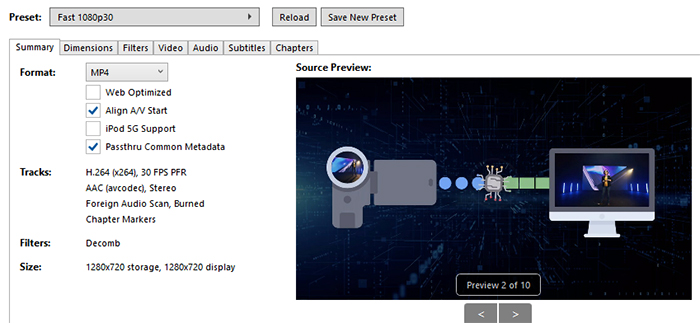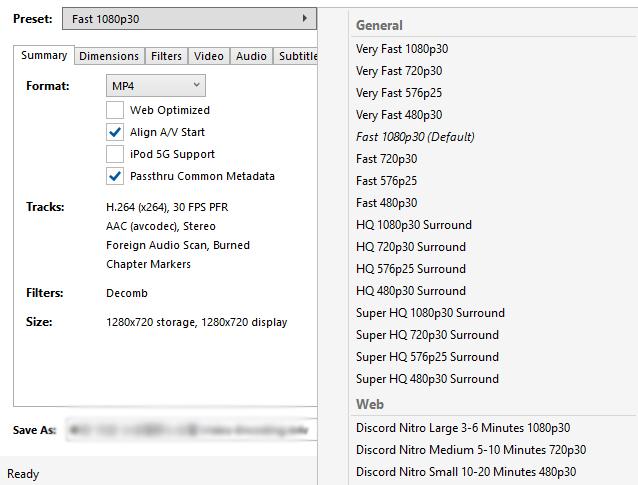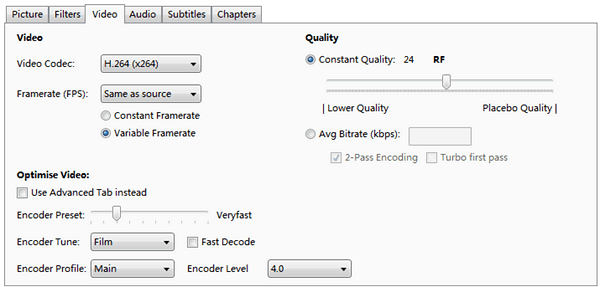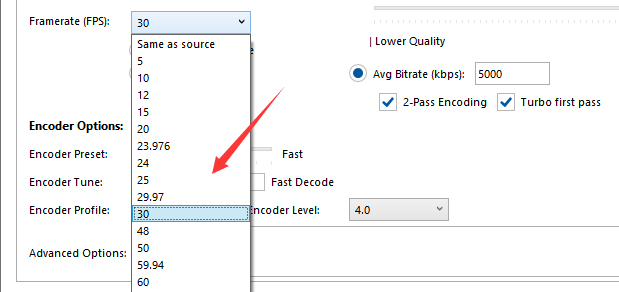Do you know that an uncompressed 1080p Full HD video can reach 806 GB at 24FPS and 90 minutes in length? That is definitely monstrous. Heavy video files like 4K and 8K videos will exhaust your device with a limited storage capacity and retard the speed when uploading or downloading. Just in the nick of time, you can download HandBrake video compressor to reverse the tide by reducing video file size at desired compression ratio.
Here, this guide will show you how to compress video with HandBrake in high quality step by step, so as to make the space-hogging videos smaller in size and more-friendly to web uploading and device storage.
Any Easier Way to Compress Videos from GBs to MBs?
Try top handbrake alternative - Macxvideo AI, a powerful 8K/4K video converter & compressor to reduce file size fast and in high quality if HandBrake video compressor encounters errors. Convert any video to HEVC/H264 codec, lower video resolution/frame rate/bit rate, trim to shorten video length, crop frame size to compress video with 60%-80% size off!
Macxvideo AI is for macOS, while Winxvideo AI (from our WinXDVD brand) is for PC.
Part 1. How to Compress Video in Handbrake without Losing Quality?
To make video size smaller, firstly you need to know the video compression is achieved by removing certain data from the video sequence. There are mainly two types of compression: remove unnecessary redundant data or remove insignificant/less important data.
The first type can exceedingly compress and reduce video size with virtually no quality loss while the second one would dramatically shrink file size at the expense of certain quality loss. And to let Handbrake compress video without losing quality, you're highly advised to use the 1st method: remove unnecessary redundant data. To make this happen, the video codec is the key instead of the Handbrake settings (bit rate, frame rate, resolution, etc.).
As we have mentioned above, video compression codec is the key to reduce video size. large-sized 1080p/4K/8K UHD video without quality loss. Yet, which video codec is the best for you to compress 1080p HD or 4K/8K UHD videos while keeping the original quality? The answer is HEVC (H265) that has much higher compression ratio than H.264, but it is not that compatible with diverse devices. So, choose H.265 or H.264 coding format based on your needs.
Preparations: The Handbrake compress video guide will request a computer, a video file, and the HandBrake itself. And at the very begining, you need get the open-source HandBrake video compressor from its official site.
Step 1: Download and install HandBrake
It is always recommended to go to http://handbrake.fr, the official Handbrake site to download this video compressor so as to avoid any malware or adware installation.
Step 2: Add the video you want to reduce file size
Click "File" in the "Source Selection" to add a video file to be compressed in HandBrake after it is kicked off. Here in the guide, we'd like to compress a 4k video in MKV that weighs in at over 24GB, around 60 minutes long, to MP4 H.264 for smaller size to give you an example.

Step 3: Set Destination Folder to save the compressed video
Click "Browse" button under "Destination" where you can save the compressed file in your local hard drive.
Step 4: Choose an output format
Choose the container MP4 in the "Output Settings". This is because MP4 has the widest compatibility with devices, players, TVs, gaming systems, and even the video sharing sites like YouTube, Facebook, etc.

Generally, the default preset in Handbrake is "Fast 1080p30". If this is not what you need, tap the option icon to open the hidden preset list. It covers Very Fast 1080p 30 -480p30, Fast series, and HQ/Super HQ 1080p30 Surround. Certainly, your primary goal is to reduce video size. Thus, you're not advised to choose HQ or Super HQ presets unless quality does matter a lot.
Drop down the list and there are also preset profiles for web, devices (Apple, Android, PS, Roku, Amazon Fire...), Matroska, Hardware, etc. Pick up the one you need. Meanwhile, you're allowed to import your own made preset into Handbrake for latter video compression. You can simply use the presets to compress video with Handbrake for the web.

Step 5: Adjust HandBrake compression settings
The video file size is mainly decided by coding format, resolution and bit rate, so below words will teach you how to set them in perfect condition so as to make your video balanced in size and quality.
1. Choose H.264 video codec: HEVC is famous for its great compression ratio that delivers half of the bandwidth data and compresses video at a file size half off the original without sacrificing the quality as compared with its predecessor H.264.
But it is currently not as widely used as H.264 now. So we recommend you to stay with H.264 in terms of both file size and compatibility. But users of iPhone 6 or above, we highly recommend you to choose H.265 in HandBrake to shrink video file size, since iOS 11 and macOS High Sierra (or later) are reported to support H.265 compression.

2. Video resolution is set to 1080p or 720p: Video resolution has great impact on the file size. However, higher resolution doesn't necessarily mean you will have a better visual enjoyment on a screen with a lower resolution. For example, a 4K video won't look better than a 1080p HD video on a HD TV. So it's advisable to compress 4K to a video, preferably 720p 30fps or 1080p 30fps for YouTube or Facebook.

3. Enter an Average Bitrate (kbps) between 5,000-10,000: More bitrate means more artifacts and better video quality and vice versa. So when you compress video with Handbrake, you can also lower the bitrate corresponding to the resolution. Generally, it's recommended to set the bitrate at around 2500 kbps for a video with a resolution of 480p, 5000 kbps for 720p, 8000 kbps for 1080p, 35000kbps for 2160p.

By following the above steps, you can customize your video file size at will. To reduce file size with HandBrake more easily and quickly, you can also follow the below ideas about HandBrake best compression settings.
Part 2. HandBrake Best Compression Settings to Compress Videos
Having a good understanding of Handbrake video settings will yield twice the compression result with half the effort. So prior to the step-by-step tutorial to reduce video file size with Handbrake, the following section will list the most recommended video compression settings that you can borrow when you compress videos with HandBrake.
On top of video codecs, you're allowed to further shrink video file size via Handbrake settings. The common parameter settings used to make video file smaller include video resolution, frame rate and bit rate. You can follow the below steps to compress video (720p, 1080p, 4K 8K UHD) with higher compression ratio. Certainly, this way comes at the cost of video quality. Hence, do not overdo parameter adjustment. Well, nonsense aside, let's cut to the chase.
1. Recommended Handbrake Quality Settings for Compression:
- 4K 2160p UHD: Constant Quality RF is suggested to range between 22 and 28.
- 1080p Full HD: RF range: 20 - 24.
- 720p HD: Start from RF 19 and end with 23.
- 480p/576p SD: the entry-level is RF 18 and the maximum level is RF 22.

2. Recommended Handbrake Frame Rate Settings for Compression:
- 4K 60FPS: 4K video with 60FPS is adjusted for playback on iPhone 8/Plus, iPhone X or latest Android flagship devices.
- Lower 1080p 60FPS to 1080p 30FPS: it doesn't have significant impact on video smooth playback. Compress video size to certain degree.
- Adjust 720p 30FPS to 720p 23.976FPS: no damage on video quality and meanwhile no big influence on file size.

3. Recommended Handbrake Bit Rate Settings for Compression:
Standard Dynamic Range:
- 4K 2160p: 35-45Mbps for standard frame rate (24, 25, 30); 53-68Mbps for high frame rate (48, 50, 60).
- 2K 1440p: 16Mbps for standard frame rate; 24Mbps for high frame rate.
- 1080p HD: 8Mbps for standard frame rate; 12Mbps for high frame rate.
- 720p: 5Mbps for standard frame rate; 7.5Mbps for high frame rate.
- 480p: 2.5Mbps for standard frame rate; 4Mbps for high frame rate.
High Dynamic Range:
- 4K 2160p: 44-56Mbps for standard frame rate (24, 25, 30); 66-85Mbps for high frame rate (48, 50, 60).
- 2K 1440p: 20Mbps for standard frame rate; 30Mbps for high frame rate.
- 1080p HD: 10Mbps for standard frame rate; 15Mbps for high frame rate.
- 720p: 6.5Mbps for standard frame rate; 9.5Mbps for high frame rate.
You don't have to 100% follow the above parameter settings suggestions. Most importanly, you ought to clearly know the purpose of video compression: video uploading, sharing, video storage or video playback. Afterwards, you can keep a good balance between video compression and video quality.
Now, you get the hang of how to compress video with HandBrake. However, pay attention to its drawbacks. For example, HandBrake only transcodes videos into MP4, MKV or WebM. Customized profiles, available for particular purposes without changing codec, bitrate, resolution, frame rate, are still unattractive in Handbrake. So, you may need a HandBrake alternative.
Once again, Macxvideo AI is recommended as the best Handbrake alternative that is fully compatible with both Mac and Windows and bounded with 420+ readymade profiles for web, iPhone, iPad, Samsung, PS4/5, Windows phone, Surface Pro, 4K TV, and more. You can reduce video file size greatly and get the perfect video quality without any issue.
Part 3. FAQs about How to Compress Video with Handbrake
1. How do I reduce the size of a video in Handbrake?
Launch Handbrake and click "Open Source" to select your video file. Choose an output location and format. In the "Video" tab, adjust the "Quality" slider to reduce video quality. Lower values result in smaller files. In the "Picture" tab, adjust the "Width" or "Height" to reduce resolution, thereby decreasing size. Lower the "Average Bitrate" in the "Video" tab. This reduces the data used for encoding, further shrinking the file. Click "Start" to initiate the conversion.
2. Does Handbrake degrade video quality?
Yes, Handbrake can potentially degrade video quality if you're not careful with the settings you choose. When you reduce the size of a video using compression software like Handbrake, you're essentially reducing the amount of data in the video file. This reduction in data can lead to a loss of detail, clarity, and color accuracy, resulting in a degraded video quality.
3. What is the maximum video size for Handbrake?
Handbrake does not impose a strict maximum video size limit, as it primarily focuses on compression and conversion. However, the actual practical limit depends on factors like your system's resources, the codec used, and the intended playback device's compatibility. Generally, Handbrake is used to reduce video file sizes while maintaining reasonable quality. For example, converting a large 4K video to a smaller 1080p version can significantly decrease the file size.
4. Why is Handbrake making my files bigger?
Handbrake might enlarge files if settings are incorrect. Lower bitrate in "Video" tab to reduce size. Choose efficient codecs like H.264 or H.265. Stick to original or lower resolution, and avoid upscaling. Use "Average Bitrate" mode to set a target size instead of "Constant Quality" mode. Adjust audio settings and remove unnecessary subtitles. Consider single-pass encoding instead of multiple passes.








